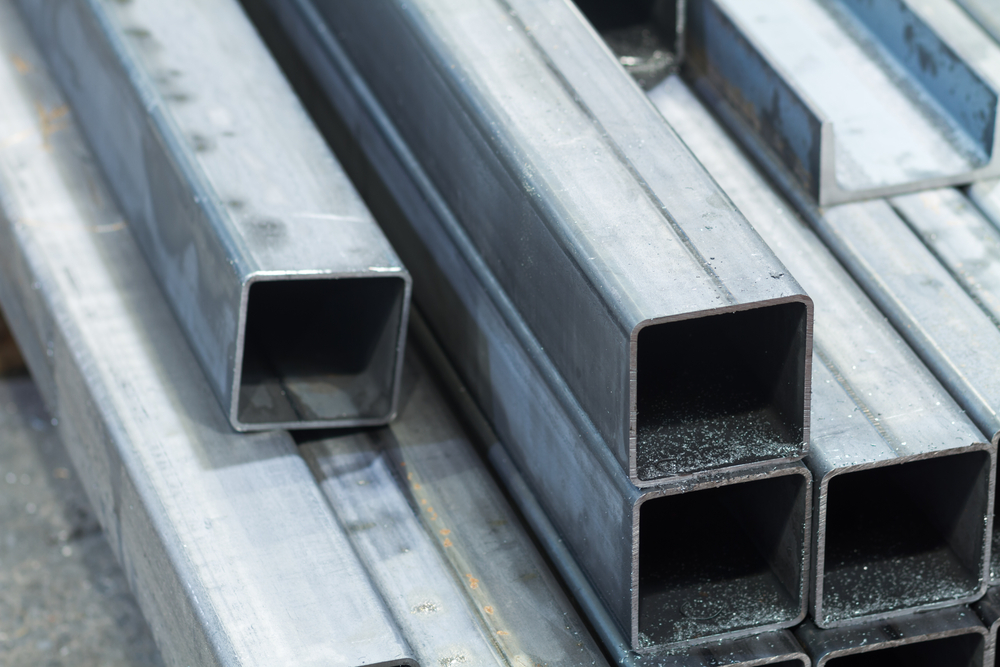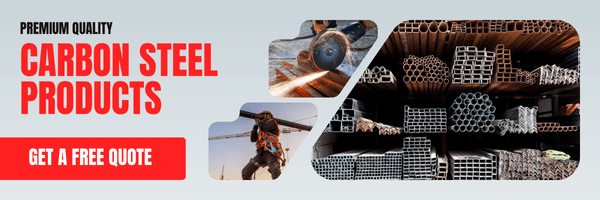CARBON STEEL VS. MILD STEEL: WHAT’S THE DIFFERENCE?
October 2, 2024 | Categorized in: Types

It’s a common question — what’s the difference between carbon steel and mild steel?
The answer is that mild steel is a type of carbon steel. However, the amount of carbon present in steel determines what type or grade of carbon steel it is.
Mild steel has the lowest carbon content of carbon steel, but that doesn’t mean it’s less useful. In fact, mild steel is the most widespread form of steel and accounts for 85% of all steel production in the United States.
Read on to learn more about mild steel and how it compares to other forms of carbon metal.
Carbon steel vs. mild steel: what’s the difference?
The element carbon is present in all steel and mild steel is a type of carbon steel. Whenever this carbon is the main alloying element, the steel is considered carbon steel. Usually, carbon steel contains about 0.05-1.7% carbon by weight. The amount of carbon present determines whether it is mild, medium, or high-carbon steel.
Below is a table for an easy comparison between mild steel properties and carbon steel properties.
|
Carbon Steel |
Mild Steel |
|
|
Carbon content |
Medium to Ultra-High |
Low |
|
Strength |
High |
Moderate |
|
Ductility |
Low to Moderate |
High |
|
Cost |
More expensive |
Cost-effective |
How can you tell carbon steel from mild steel?
There are various methods to identify mild steel from other types of carbon steel with higher carbon content. Some of the most common ways to identify mild steel include:
- Visual inspection
- Spark testing
- Magnetic properties.
While these methods can help in identifying mild steel, they may not be foolproof, and in some cases, more advanced testing would be required.
How is carbon steel made?
Carbon steel is made from the conversion of iron ore into steel. The primary source of carbon in carbon steel is typically coal-derived coke, which is used as a reducing agent to remove impurities from the iron ore. The specific details of the carbon steelmaking process can vary depending on the type of steel being produced and the technology used by the steel manufacturer.
What does carbon do to steel?
When added to iron to make steel, carbon influences its mechanical properties, including hardness, strength, and toughness. It also affects the steel’s ability to be heat-treated, its machinability, and its response to welding. The balance between carbon content and other alloying elements is crucial in designing steel alloys for specific applications.
How strong is carbon steel vs. mild steel?
It is commonly asked whether carbon steel is stronger than mild steel, but this is another trick question because mild steel is a type of carbon steel. However, there is a difference in hardness between the different types of carbon steel. Generally, the higher the carbon content in steel, the harder the steel is.
However, this also means that the stronger the steel, the more brittle it is. This means that high-carbon steel is harder than low-carbon steel grades but is also more brittle. This balance between hardness, ductility, and malleability makes mild carbon steel the ideal choice for most applications.
Can mild steel be hardened?
Hardening mild steel typically involves a process called case hardening or surface hardening. This method only hardens the surface layer and requires tempering to reduce its brittleness. It’s important to note that while this can increase the surface hardness of mild steel, it may also affect its ductility and toughness.
Types of carbon steel
As mentioned earlier, all steel contains carbon as the main alloying element, but the amount of carbon present dictates the type of steel grade and its properties. The choice of carbon steel type depends on the specific requirements of an application, taking into account factors such as strength, hardness, ductility, and toughness. Here, we break down the differences between mild steel, medium carbon steel, high, and ultra-high carbon steel.
What is mild steel?
Mild steel, also known as “low-carbon steel,” is the most common form of steel for many reasons. It costs less while providing the material properties needed for most industrial applications. With approximately 0.05–0.25% carbon, mild steel’s composition makes it malleable and ductile. While mild steel has a lower tensile strength than other carbon steel types, it is more pliable and easier to form. You can also harden mild steel with various treatment processes. Mild steel is machinable and weldable, which aids in its usefulness for most applications.
Common uses of mild steel include:
- Building construction
- Pipelines
- Automobile manufacturing
- Wiring
Medium-carbon steel
Medium-carbon steel has approximately 0.3–0.6% carbon content. Medium-carbon steel may be heat-treated by austenitizing, quenching, and then tempering to improve its mechanical properties. It’s most often utilized in a tempered condition, having microstructures of tempered martensite. Medium-carbon steel balances ductility and strength. This grade of steel is primarily used for applications that call for a combination of high strength and wear resistance.
Common used of medium-carbon steel include:
- Machine components
- Gears
- Axles
- Forgings
What is high-carbon steel?
High-carbon steel has approximately 0.6 to 1.0% carbon content. High-carbon steel is almost always used in a tempered condition, making it wear-resistant and capable of holding a sharp cutting edge. The hardness and sharpness make it suitable for cutting tools and blades. High-carbon steel’s hardness is higher than other steel grades, which comes with a price when it comes to ductility. The higher the carbon content in steel, the less ductile it is.
Common uses of high-carbon steel include:
- Hand tools
- Knives
- Concrete reinforcement
- Springs
What is ultra-high-carbon steel?
Ultra-high-carbon steel typically contains carbon content in the range of 1.25% to 2.0%, or even higher. This high carbon content makes it distinct from most other types of carbon steel. This type of carbon steel is characterized by its exceptional hardness and wear resistance, making it suitable for specific applications where these properties are essential.
Common uses of ultra-high-carbon steel include:
- Surgical instruments
- Bearings and rollers
- Industrial blades
- Specialized automotive parts
Service Steel Warehouse – your carbon steel supplier
Understanding the different types of carbon steel is crucial for making informed choices in various industries and applications. From ductile and versatile low-carbon steel to the robust and hard-wearing high-carbon and ultra-high-carbon varieties, each type offers a unique set of properties that can be harnessed to meet specific needs. Whether you’re building structures, crafting precision tools, or seeking the sharpest blades, the right choice of carbon steel is essential.
If you’re looking for a knowledgeable and experienced carbon steel supplier, Service Steel Warehouse is here to help!
We offer high-quality steel products including piling, beams, channels, pipe, sheets, and more. Not only do we have a wide inventory of products, but we also offer finishing services to process your order to your exact specifications, such as product sawing, galvanizing, and painting. If you’re unsure which service is right for your needs, talk to one of our steel professionals today.

